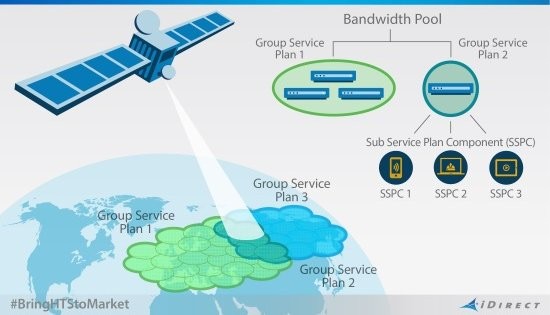
Managing Bandwidth Across HTS Spot Beams
In his recent blog Denis Sutherland, iDirect’s Director of Business Development, points out the challenge facing Satellite Operators when it comes to having the right amount of satellite capacity available in the right place over the lifetime of the satellite. This is critical to the success of Satellite Operators launching High Throughput Satellites (HTS). And managing that bandwidth across multiple HTS spot beams comes with a set of additional considerations for both Satellite Operators as well as Service Providers. Why is that?
Managing HTS bandwidth across multiple spot beams, compared to a single wide-beam coverage is a challenge. It comes down to being able to maintain Service Level Agreements (SLAs) across the entire customer network by managing the network capacity on multiple spot beams as one single bandwidth pool.
Think also about the difference in operational economics that come with multiple spot beams. Service Providers who are only using a few MHz on each beam would need to equip multiple spot beams with ground infrastructure versus just a single wide beam. That’s why we see more Satellite Operators planning to pre-populate multiple spot beams with hubs and line cards to allow Service Providers to cost-effectively operate regional networks. It is for these reasons that we expect to see more Satellite Operators coming down from space to start offering managed services.
It will have a direct impact on the business models for how Satellite Operators will bring HTS to market. Check out this infographic that describes the HTS business models in more detail.
Thus far, the most common model we have seen play out with HTS is the Satellite Operator as the principle owner and operator of the platform, managing bandwidth on one or more satellites. Depending on the business model, the Satellite Operator sells a Mbps service to Service Providers or end-customers directly.
The Satellite Operator can determine the level of management and control it grants to the Service Provider. They can offer a fully managed service with pre-defined service plans to Service Providers or they can offer a partially managed service leaving a certain degree of flexibility to the Service Provider to set its own service parameters and contention ratios just like they have been used to under the traditional VNO model.
For Satellite Operators offering Mbps type of services rather than MHz on a large scale, this means they need to manage the bandwidth across multiple spot beams as one single bandwidth pool.
Global Bandwidth Management
This demands a special bandwidth management capability and iDirect Velocity® is designed specifically with this in mind. We call this unique feature set Global Bandwidth Management (GBWM).
GBWM allows for multiple levels of group service plans to be created across a common pool of bandwidth. This bandwidth pool can be further divided into sub bandwidth groups and service tiers.
You can see in the diagram above that multiple spot beams can be grouped into Global Service Plans (GSP) and further partitioned into sub GSPs for different Service Providers. Each Service Provider can be in control of setting their own service parameters per GSP and divide it further into service components called Subscriber Service Plan Components (SSPCs) for their offerings to end-customers.
This is one example of how Intelsat plans to offer iDirect Velocity based IntelsatOne® Flex service as is Telenor on Thor7.
Managing Bandwidth Across Multiple Spot Beams
For the Satellite Operator offering Mbps offerings to Service Providers in a particular region or for a group of beams this means they have to manage the contention among service providers’ bandwidth plans. These service plans each come with different applications and different peak times throughout the day thus impacting the fill rates in each beam.
Add to this the complexities of managing the shifting bandwidth demands generated by remotes that are mobile. In such scenarios, Satellite Operators must fulfill service plans for remotes entering and leaving smaller spot beams much more frequently than in wide beam coverage. You can see how for Satellite Operators this will result in beams not being evenly loaded in all parts of the coverage at all times. Load sharing and Service Scheduling options and Geographic Scope are all features as part of Velocity’s Global Bandwidth Management System that give Satellite Operators the added flexibility to better manage congestion and optimize fill rates on a very large scale.
Helping Satellites Change Their “Spots”
Recently I had a conversation with a Satellite Operator who looked at iDirect Velocity’s benefits from a more holistic side: The intelligence build into Global Bandwidth Management allows Satellite Operators to manage and adjust the satellite’s multi spot beam capacity over the lifespan of the satellite. That would mean iDirect Velocity enables Satellite Operators to change their “spots” after all.
First published on blog.idirect.net